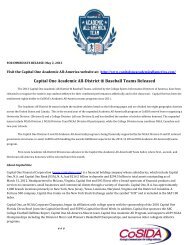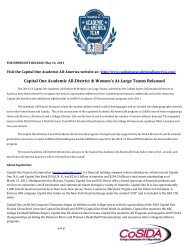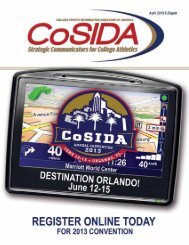CoSIDA E-Digest March 2013 • 1
CoSIDA E-Digest March 2013 • 1
CoSIDA E-Digest March 2013 • 1
You also want an ePaper? Increase the reach of your titles
YUMPU automatically turns print PDFs into web optimized ePapers that Google loves.
<strong>CoSIDA</strong><br />
Access (29.9% of respondents): Numerous respondents used the term “reach” when describing the key advantages<br />
of social media. A graduate assistant from a NCAA III institution summarized this advantage in this way, “Developing/<br />
strengthening our organization’s (or our athletic department’s) relationship with current/former/potential students, alumni,<br />
friends, family members and media; Reaching people and media members who may not visit our website or campus<br />
on a regular basis.” A director at the community college level observed, “With traditional media shrinking and coverage<br />
of small colleges scant, social media combines with university websites to create coverage and reach audiences that<br />
were previously inaccessible.” Another professional working at the associate/assistant level at a NCAA I school cited the<br />
opportunity for “consistent communication with fans.”<br />
Targeted (17.7% of respondents): The ability to target particular audiences, whether they are students, alumni or avid<br />
fans, was another commonly cited advantage. A director at a NCAA II school stated, “The people that check these<br />
items have a direct and expressed interest in your organization.” A graduate assistant a NCAA III college took it a step<br />
further. “Key influencers are on social media and will pass along information that they find relevant. Additionally, these<br />
people have opinions that influence others and if they are on your side, they can be very beneficial to your organization.”<br />
A director at a NCAA I institution concluded, “By now, social media are so wholly integrated into an organization’s<br />
communications platform that audiences are accustomed to using them. To ignore social media would be foolish.”<br />
Management (9.4% of respondents): The ability to bypass media gatekeepers and communicate directly with key<br />
audiences was another frequently cited advantage. A director at a NCAA I school characterized this as a “first-person<br />
voice instead of third-person interpretation” that “creates community and engagement across audiences that carry the<br />
same interest.” Another director at a NCAA I institution described social media communication as being “a more trusted<br />
and less corporate voice than what comes from a professional PR office.”<br />
Content (8.6% of respondents): In discussing the various aspects of the content shared via social media, respondents<br />
touched on several characteristics from its timeliness to its accuracy to its brevity. A respondent working in an associate/<br />
assistant position at a NCAA III school also emphasized interactivity. “Many mainstream media sources seem to be<br />
more open to looking at links to videos, stories, etc., that are posted on social media. Social media as a whole is more<br />
interactive than any other means of getting our stories out that we’ve had in the past.” Several others noted the advantage<br />
of social media communication driving audiences to websites or other forms of organizational communication.<br />
Cost (6.8% of respondents): None of the respondents offered detailed comment regarding this advantage. The terms<br />
“cheap,” “cost effective” and “free” were frequently cited, however.<br />
Feedback (5.7% of respondents): A number of answers included the term “interactive.” A director at a non-NCAA<br />
institution described the advantage as “the ability to carry on conversations in real time and receive feedback almost<br />
immediately.” An associate/assistant director at a NCAA I school also described the way social media “makes feedback<br />
less anonymous. You can put a face (on it), and people tend to temper their criticisms with their name next to a comment.”<br />
Ease (4.7% of respondents): Several answers touched on the ease of social media usage by both communicators and<br />
members of their audiences. Speaking from the communicator’s perspective, a director at a NCAA III institution said, “I<br />
have found social media to be quite easy to use as I usually link the stories I publish on the web to Facebook and Twitter.<br />
Preparing video for YouTube is more time intensive.”<br />
Students (4.4% of respondents): Enough respondents specifically mentioned the advantage of reaching students via<br />
social media for the subject to warrant its own category. A director at a NCAA I school wrote, “Young people are more<br />
reliant on getting their information from social media. Attention spans have decreased so short, social media bursts help<br />
in getting your general message out to a broad based group. Interested fans will dig deeper to get more information but<br />
many times the young people only want a headline or quick fact.”<br />
Credibility (2.1% of respondents): Several respondents discussed source credibility and its impact on organizational<br />
transparency. An associate/assistant director at a NCAA I institution opined, “It allows greater proximity to what previously<br />
might be perceived as a closed off entity. I think it helps in transparency to the general public as well.”<br />
<strong>CoSIDA</strong> E-<strong>Digest</strong> <strong>March</strong> <strong>2013</strong> <strong>•</strong> 65
















